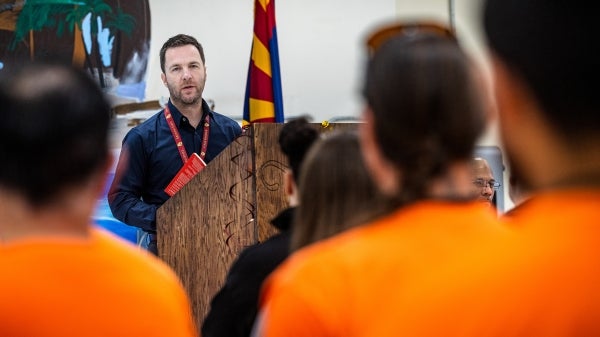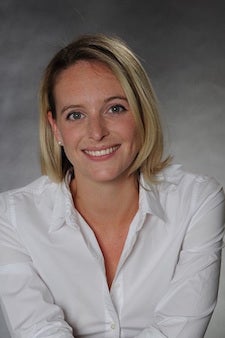ASU research finds that when it comes to college choice, it pays to reach

Arizona State University stands out among higher-resource colleges because it doesn’t set out to reject a large number of applicants, instead providing transparent admissions standards as a way to widen access, a professor of economics who studies college choice said.
That access is important because a college degree can nearly double the prospective income for graduates, thanks to the “college premium” — the wage gap between those with a degree and those with only a high school diploma.
It especially pays off for students to “overmatch” by reaching for the best college they can, according to research by Eleanor Dillon, an assistant professor of economics in the W. P. Carey School of Business at ASU, who has done several research projects on college choice.
Eleanor Dillon, an assistant professor of economics at ASU, studies college choice.
Her recent work found that regardless of academic ability when they apply, students who attend higher-resource colleges had better chances of graduating and higher-paying jobs later in life. And students who had more access to information — such as high schools that sent a lot of students on to college — were more likely to make that reach for a better institution. That means academically talented students whose families or schools don't have that knowledge can lose out.
“Right now, we live in a world where the resources devoted to you in college are not simply a function of your academic aptitude,” Dillon said. “They’re also in large part depending on your family financial resources — but more importantly, information resources. Students may not realize they are really good students, and that these options are available to them and how much better off they would be.”
Dillon's studies assessed college resources on several factorsIn the study, a college’s resources were determined by the mean SAT score of entering students, the percentage of applicants rejected, the average salary of all faculty engaged in instruction and the undergraduate faculty-student ratio., including applicant rejection rate.
“If you want to move your school up the rankings, you should recruit a bunch of applicants and reject them all. You haven’t gotten any better but now you look good according to those metrics,” Dillon said.
“ASU does the reverse of that. It posts its admissions threshold on its website so the rejection rate is tiny because everyone knows whether they can get in or not. If you’re over the threshold, you’ll get in, and if you’re not, you don’t apply.”
When it comes to six-year graduation rates, ASU fares well, she said. And at all colleges, the more resources that are expended per student, the better they do. Even less-prepared graduates of top colleges had higher incomes at age 28 compared with those at lower-resource colleges, according to the study.
Some academically talented students “undermatch” by going to a lower-resource college, and some less-prepared students “overmatch” by going to a high-resource college, the research found. But simply reshuffling the admissions wouldn't help achieve equity for all because there are a limited number of seats at elite colleges.
“If we want to improve average outcomes, we need to devote more resources to our students. So it’s a rather expensive conclusion to draw,” said Dillon, whose collaboratorBoth of their studies are forthcoming in the Journal of Labor Economics. was Jeffrey Smith of the University of Michigan.
Dillon has found that her research field of college choice is always a hot topic, driven by the high interest in rankings and also by the college premium.
“How people decide how they’re going to invest in themselves is the first question I was interested in in economics,” she said. “We make our own choices about education, and we make choices for our children about education, and it’s a topic that huge number of people can connect to.”
The wage gap changed rapidly. In 1980, workers with a college degree earned about 45 percent more than workers with only a high school diploma, but by 2002, college graduates were earning 94 percent more than high school graduates, according to the U.S. Bureau of Labor Statistics.
Dillon is looking deeper at that gap in her current research project, done with Gregory Veramendi, an assistant professor of economics in the W. P. Carey School of Business. She said one reason for the gap might be because of the skills learned in college, but another reason might be because college-goers already possess certain traits, such as higher cognitive skills, discipline and self-organization.
“So perhaps that creates a larger earnings gap not because those students went to college, but because they’re the kind of people who went to college,” she said.
More Arts, humanities and education
Autism diagnosis leads ASU professor to write book about neurodiversity and literature
Bradley Irish always knew his mind worked differently.But it wasn’t until two years ago that Irish, an associate professor in Arizona State University’s Department of English, discovered why.He was…

ASU professor, Arizona inmate work to rehabilitate the 'imprisoned mind'
An Arizona State University professor has collaborated with an Arizona inmate on a book that examines why investing in healing prisoners would benefit everyone.“Imprisoned Minds: Lost Boys, Trapped…
Illuminating legacy at ASU
In 2020, the ASU Art Museum unveiled a groundbreaking installation, "Point Cloud (ASU)," by renowned artist Leo Villareal. The art piece was given a permanent home on the Tempe campus in 2024 thanks…
